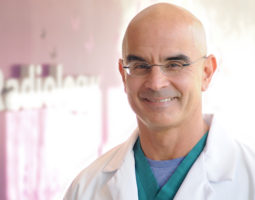ACCELERATE Education
With a gift to the Charles A. Rohrmann, Jr., M.D. Endowment for Radiology Resident Educational Excellence.
Give Now >Serving MD, MD/PhD, Res., Fel., PhD, PA-C (MEDEX), MA, MS, BS, PT, OT and P&O alumni, your UW School of Medicine Alumni Association is the place to connect with your classmates, your School and the next generation of medical professionals.

850 Republican Street, C-5
Seattle, WA 98195-8045
 When you imagine a radiologist, you might think of someone in a white lab coat interpreting images of CAT scans and MRIs — someone a little distant and reserved. But that couldn’t be further from the truth, says alumnus and radiologist Jim Murakami, M.S. ’95, M.D., Res ’96, Fel. ’97.
When you imagine a radiologist, you might think of someone in a white lab coat interpreting images of CAT scans and MRIs — someone a little distant and reserved. But that couldn’t be further from the truth, says alumnus and radiologist Jim Murakami, M.S. ’95, M.D., Res ’96, Fel. ’97.
As a pediatric interventional radiologist at Nationwide Children’s Hospital in Columbus, Ohio, Murakami interprets images of all kinds as part of his job: treating children for tumors and congenital malformations using a specialized, non-invasive surgery called sclerotherapy.
It’s a job that creates really strong bonds.
“This level of intimacy can sometimes cause no small degree of heartache,” says Murakami. “But there is nothing like getting a hug from a grateful two-year-old.”
Murakami’s job is founded on relationships with his patients, with their parents, and with his colleagues. The importance of relationships is a tenet — one internalized from his own mentors at UW Medicine and Seattle Children’s — that he emphasizes when he’s training junior radiology specialists.
“I was fortunate to train at Harborview Medical Center with several instructors, including Chuck Rohrmann, who were incredibly smart,” says Murakami. “Together, they represented nearly 150 years of experience.”
In medicine, experience may dictate that you take immediate action. Or, sometimes, that you wait and see.
Just the other day, for example, Murakami saw a young, asymptomatic patient with a bone tumor in his back. It appeared to be shrinking on its own. Murakami decided to wait several months to see if the condition would resolve, rather than risking injury with more immediate treatment. “Sometimes waiting is the safest and most common-sense solution to a problem,” he says.
Patients travel from around the world to see Murakami because the type of therapy he practices isn’t offered many places. He and his colleagues work to help families negotiate the hurdles of travel and cost.
“When I left medical school, I certainly didn’t anticipate I would be dealing with the travel, the finances and the housing related to getting care,” says Murakami. “But I view the job of the physician to help the families — whatever that means.”